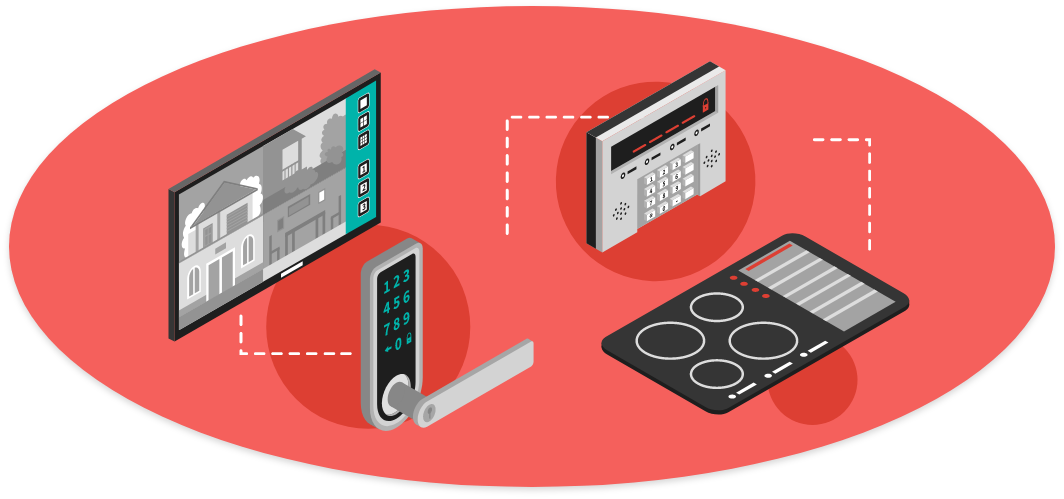How to Secure Your Home with Automation & Smart Technology Guide
Introduction
Advanced technology over the years has not only shaped the way we communicate, but also how we protect our homes. Technology allows us to link different devices and connect beyond just computers and smartphones. Nowadays, it is pretty common for people to also connect many of their home elements like garage doors, doorbells, door locks, speakers, lights, clocks, and other electronic devices for optimal security. Keeping an eye on your home away from home has never been easier!
Home automation involves your devices communicating with each other to send you information and follow your commands. It is convenient to use once you get everything set up properly because you can control the different elements in your home with it! Saving electricity and having improved security are just two of many perks of home automation. In this guide, we will go over the different ways automation & smart home technology can provide home security.
What the Experts Say
Industry experts have provided insightful tips on how automation & smart home technology can make homes much safer today:
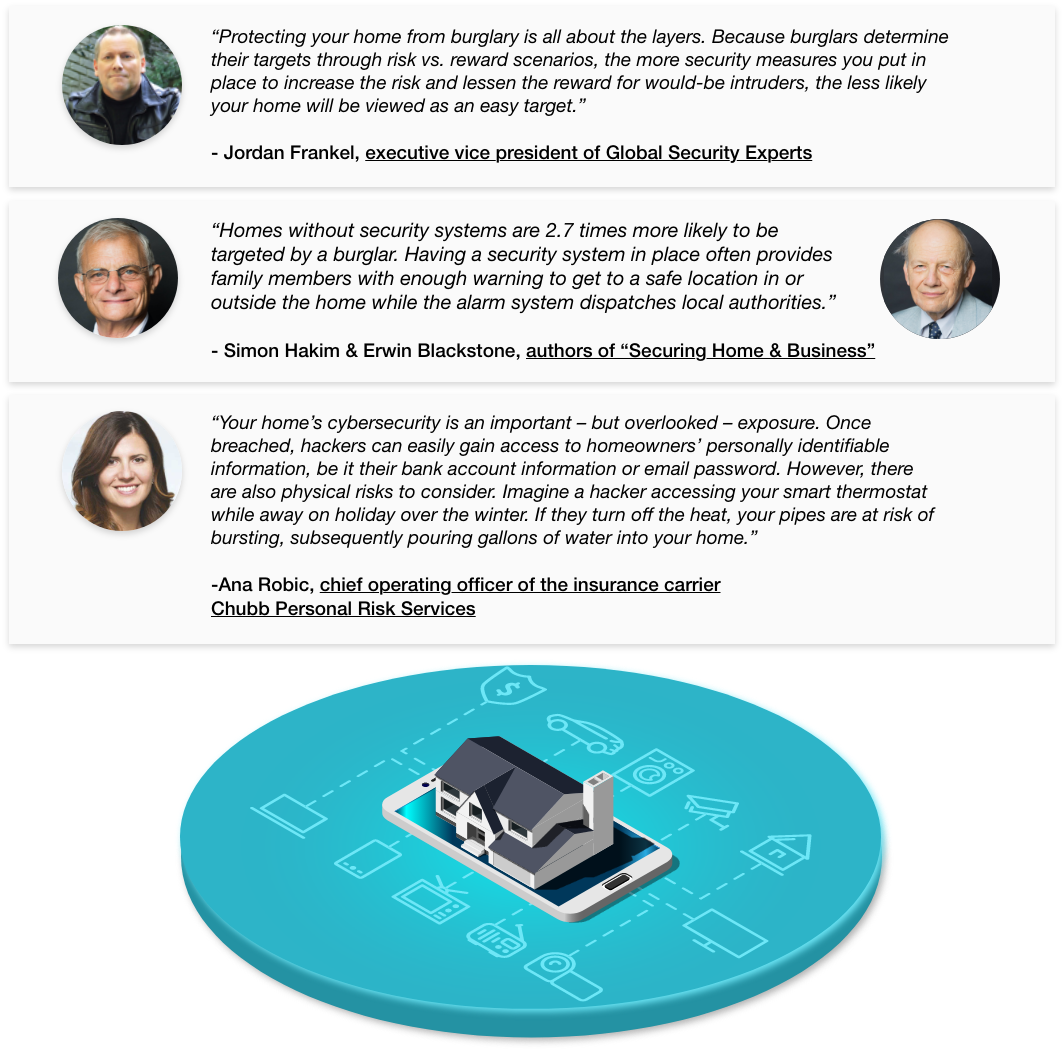
 Hardware for Securing Your Home with Technology
Hardware for Securing Your Home with Technology
Are you looking to amp up the security of your home using technology, but are not sure where to start? We are here to help you get started! Let’s take a look at some of the technologies you can implement into your house to make it safer, whether you’re at home, at work, or out of town for vacation.
 Bluetooth Door Locks
Bluetooth Door Locks
An essential part of home automation installation is smart locks, which have helped to make homes more secure. Smart locks can be connected to your mobile phone through Bluetooth, or by using an app on LTE or Wi-Fi. The neat thing about smart locks is that they can detect your presence automatically and connect to all automation systems. This way, you’ll also be able to control other things like lights, thermostats, etc. You can truly save a ton of energy using bluetooth door locks over time! Keep in mind that while Wi-Fi locks may have more features, the ones with Bluetooth technology are more secure.
 Smartphone Controlled Sensors
Smartphone Controlled Sensors
You can detect movements anywhere in the house with smartphone controlled sensors. Home sensors can sense your presence as you enter or leave the house, and you can even install these sensors on doors and windows for optimal security. By activating these sensors, you will receive alerts on any motion detected by the system. This way, you can stay informed in case of a break-in no matter where you are.
 Cameras with Wi-Fi
Cameras with Wi-Fi
The good news is that there are plenty of security cameras constantly entering the market. This means that there is a growing selection to choose from, and they are becoming more affordable. Modern smart cameras rely on Wi-Fi and connect to your smartphone. Once connected, you will be able to monitor your home with a live stream. See who is coming in and leaving your house while you are not around.
 Security Cameras & Remote Monitoring
Security Cameras & Remote Monitoring
Remote monitoring is a wonderful feature, now possible with the advent of the Internet. You can virtually keep an eye on your house no matter where you are. This gives homeowners peace of mind especially if they are away from home due to long work days or if they travel often. Simply connect the security cameras in your home to your smartphone to get a view of each room whenever you want.
Another perk? If someone breaks in and tries to disarm the security system, you will be alerted. Not only do security cameras work to discourage criminals from burglarizing your home, but it also helps to catch them in the event that they do carry out any crime.
 Outdoor Cameras
Outdoor Cameras
While monitoring the interior of your home is essential, keeping an eye on the surroundings of the home are just as important. Thieves will often check out a house several times before breaking in. Outdoor cameras will help to warn you of potential thieves, as well as ward some off as they know they are being recorded. There are even cameras with motion detectors that will set off a bright flood light and/or siren, scaring off the thief.
Outdoor cameras are weatherproof, and can be plugged in, directly wired into your electricity, or battery powered. There are pros and cons to each power source, with battery powered being the most convenient in the initial setup as you can easily set them up anywhere. The downside is that you would need to recharge or replace the batteries on a regular basis.
You can also set motion boundaries, so that you only receive alerts if there is movement within 5 feet, 10 feet, or up to 50 feet of the camera’s sensors. This way, if you are near a busy street, you can be alerted only when someone comes onto your porch, rather than being alerted every time a car drives by.
 Fingerprint Scanners
Fingerprint Scanners
Lock and key systems have come a long way - from the traditional lock and key, to passwords & pin codes, to fingerprint scanners! Fingerprint scanners are not only convenient to use, but are also very secure.
Only those with an authorized fingerprint would be able to unlock the house. This system does not have the same pitfall as the passwords & pin codes approach, where unauthorized users can still hack it by trying a bunch of different combinations. The traditional lock and key approach can be risky if a stranger somehow gets a hold of your key and makes copies, or if you are renting out your home and many people have had access to the home that way.
Fingerprint scanners depend on the intricate patterns of each finger, which cannot be replicated by another individual. Fingerprints cannot be shared or lost, and homeowners no longer have to remember any codes or their home keys!
 Intelligent Garage Systems
Intelligent Garage Systems
A remote garage door opener can come in really handy, especially if you are a frequent traveler. You can easily grant access into your home to a family member or neighbor on a need-basis, from anywhere in the world! You can easily open and close the garage door remotely. If for whatever reason your garage door is open while you are away, you will be alerted immediately. This gives you an extra peace of mind because you will know when someone tries to get into your home through your garage.
 Window Sensors
Window Sensors
By installing window sensors, you can be alerted when any suspicious activity occurs. Window sensor systems typically allow you to create cause and effect options. For example, you can set it so that if your door opens while you are away, you receive a text to notify you. If you have a lot of windows at home, this would be a great way to protect the perimeter of your house!
 Glass Break Sensors
Glass Break Sensors
Glass break sensors are solid additions to any home security system, especially if you have a lot of windows at home. Whenever the sensor picks up the specific sound that glass makes when it breaks, you will be notified. This way, you can look into what could have happened or if someone broke in while you were out of the house.
 Light Automation
Light Automation
Use light automation to make your home look occupied even when you may be away. This feature is especially useful at night or when you are away on a trip. Give people the impression that someone is at home by setting up lights to go on and off at certain times, so that criminals are less likely to try and break in. Light automation can also be a useful safety tool for the elderly if you have any older family members living at home with trouble getting around to turn lights on and off.
In addition to having light automation installed inside your home, you may also find it worthwhile to also have some sort of light automation system set up outside of your home as well. Add automated torch lights, and motion lights in your backyard and other exterior areas of your home that could be used as a point of entry. By keeping these areas well-lit, you will likely scare away potential intruders.
 Smart Doorbell
Smart Doorbell
Video doorbells are a big advantage to home security for several reasons. If you are still using a traditional doorbell, consider what that means:
- You have to go near the door to open it & address the need.
- You are essentially implying that you are not home when you do not answer the door.
- You have to go near the door to see who’s there.
On the contrary, installing a smart doorbell would mean that you get to:
- Answer the door without being near the door. You can find out who is at the door via live video and answer using audio. It is always a good idea to keep a safe distance from a stranger.
- Record & download any suspicious activity.
- Clearly see who is at the door even after the sun is down thanks to infrared night vision camera technology.
- Snap a photo of someone at the door as necessary.
- Answer the door remotely wherever you are using two-way audio, so nobody will have to know whether you are home or not.
 Digital Door Viewer
Digital Door Viewer
Consider replacing your door’s traditional peephole with a digital door viewer. They definitely provide better home security, and are quick and easy to install! Outsiders will not be able to tell whether it is a camera or not, because digital door viewers look identical to regular peepholes. The difference is that you can safely see who is outside without letting anyone know whether or not you are at home. Kids and elderly can also feel safer knowing they do not have to get near the door to see who is outside. Most digital door viewers also come with portable peephole covers, which prevents people from looking in using a reverse peephole tool.
 Smoke Alarms
Smoke Alarms
Home safety is more than just protecting yourself and loved ones from potential intruders and thieves. It also entails preventing fatal fires, and inhalation of smoke and toxic gases which could lead to health problems. Properly installed and maintained smoke alarms are crucial because they will go off whenever they senses any smoke. Families are then given a warning and hopefully enough time to escape somewhere safe, or see what is causing the smoke smell at home. It is best to install one in every bedroom, outside each sleeping area and on every level of the home, including the basement. They should be installed at least 10 feet from a cooking appliance to minimize false alarms while cooking.
 Motorized Blinds
Motorized Blinds
One of the more unique, yet obvious technological additions to home security, is the advent of motorized blinds. Just like other automated technologies in a home, motorized blinds can be programmed to open and shut at random times to give the appearance of someone being home. Motorized blinds can be synced up as well, to be sure that every window is covered at night time, preventing peering eyes from the seeing inside the house. Adding motorized blinds provides another layer of security to really make potential thieves think there is too much risk in breaking into your home.
 Automation Options For Home Security Devices
Automation Options For Home Security Devices
Managing all of the security devices in your home can be very overwhelming, to the point that most people end up rarely using it all. Turning off cameras and sensors when your home to have privacy, turning them back on when you leave or at night gets very tedious very quickly. To bypass switching everything on and off, you can automate it all with the following options.
IFTTT (If This Then That)
IFTTT is the most popular and easily accessible automation app on the market. It does not cost anything up front unless you are planning to do really advanced functions or more than 750 functions per month (far more than the average home user would need). With IFTTT compatible security devices, you can set triggers and actions that will automatically turn on your security cameras and sensors when you leave the house, and turn on your lights when you return home. You can set your devices on a schedule if you do not want to use the location of your phone as a trigger, or set the activation of one device to trigger other devices to turn on. There is a robust community that uses IFTTT to help out with any questions, and you can even download actions that others have created for their security devices.
IoT (Internet of Things)
IoT is the name for how many modern devices communicate with each other through your Wi-Fi router. With IoT enabled devices, you will be able receive notifications from your security devices, as well as control them. For example, you can turn security cameras on or off, activate sensors, lock doors, and close the garage from wherever you are. As discussed in this guide, there are security vulnerabilities with so many devices that are IoT enabled. With that said, you should take precautions with ensuring your home network and security devices are safe from hackers.
Home Assistants
There are several home assistants on the market today that can also make automating your home security system easier and more informative. Apple, Google, Amazon, and a few other companies have their own versions of a home assistant. One of the most convenient features of home assistants is how you can simply speak aloud to check on security system notifications, and to turn them on or off. If you already have a home assistant, then make sure the security devices you purchase are compatible with it, so that you can also set automated tasks such as schedules for turning on and off, when to send summaries and how often of any notable activities picked up by your security devices, and so on.
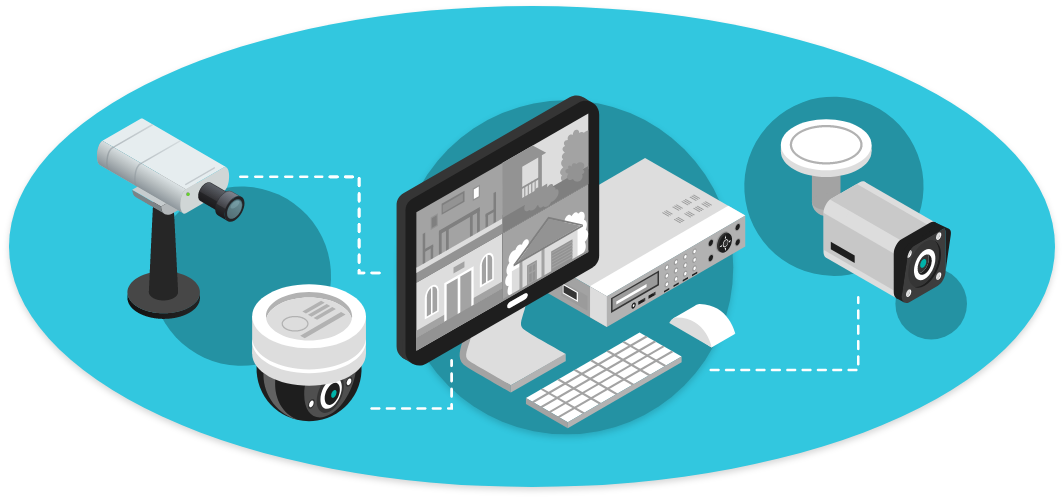
Safety Measures to Take to Ensure Your Devices are Safe
Often times, securing your home with cameras, sensors, alarms, and other security devices may make you feel like your house is a fortress. But without setting up barriers to your Wi-Fi network and ensuring your devices are updated with the latest security patches, then a hacker could just as easily use your security devices against you. Systems without firewalls, VPNs, and virus detectors can leave your house wide open to hackers, who could exploit a vulnerability in your software, and unlock your doors and deactivate your cameras. Below are home network security tips to consider.
- Always use strong passwords that you don’t use for anything else when setting up your router and home network. If a hacker found out one of your passwords from a website security breach or some other method, then they still won’t have any chance to hack into your router and see everything that is connected to your home network.
- Make sure your router is using an encryption method. WPA2 is a common encryption method and can be accessed through your router. Generally, it is activated by default.
- Create a guest network. This will make sure visitors don’t have access to the same network that your security devices are on. Your visitors may not have the same security features on their laptop or phone, and could be a gateway for hackers to get onto your network.
- Make sure none of your devices are using the default passwords they came with. To make the initial setup easy for consumers, many devices come with a default password like ‘admin’. Hackers will know this, so be sure to change it when you’re setting it up.
- Don’t manage your security devices through public WiFi when you’re away. Public Wi-Fi can have lots of vulnerabilities, through which hackers can get access to your info, and use that info to get into your home network. Always use a VPN when on public WiFi if possible, as we’ll go over in the next section.
- Use Two Factor Identification when available. Some devices will come with 2-Factor Identification to access their associated apps, be sure to always enable it as it adds a huge barrier against hackers.
- Routinely check devices to ensure there were no outages that reset their settings. We all know how annoying it is to reset clocks on the oven and elsewhere when a power outage occurs. Be diligent in checking that all your devices are operating with the security features you set them on, and did not reset to default settings that are much easier for hackers to break through.
 Software for Securing Your Home’s Security Devices
Software for Securing Your Home’s Security Devices
You have all the hardware to secure your home, and the home network security tips to add layers of security against hackers. Now we’ll go over the top software programs to use to really seal any holes that hackers are known to use to gain access to your home security systems.
Firewalls
A firewall basically allows for your home network to communicate with devices on the network and make outward connections to the internet, while blocking any unauthorized outside connections. A firewall should always be installed and turned on to protect your home and privacy. In the event a hacker finds a weakness in one of your security devices, the firewall will prevent the hacker from accessing your entire home network. Without a firewall installed and working on all your computers at home, then that hacker could potentially figure out personal passwords, credit card information, and deactivate security devices.
VPN
Having a virtual private network installed onto your home router will create a nearly impenetrable tunnel for the activity going back and forth between your security devices to your phones and computers. Installing a VPN properly is a bit advanced, but putting in the time to install it right will add a very strong layer to your security devices and should not be overlooked.
Firmware Updates
Lastly, you will want to stay on top of firmware and software updates to your security devices. Every manufacturer has employees or consultants checking on their devices for any security flaws. When they discover one, they will release an update, or often times called a patch, to fix the flaw so that hackers can not exploit it. Updates can be released on a very regular basis, or very infrequently. Following the social media accounts or ensuring you are signed up for the manufacturer’s newsletters is a good way to stay informed of any updates they may have released.

 Home Security Statistics & Facts to Ponder
Home Security Statistics & Facts to Ponder
Still on the fence about getting on board with a home security system? Take a look at some of these alarming statistics and facts; you may just make up your mind!
- A robbery is reported every 14.5 seconds.
- A home fire is reported around every 20 seconds.
- The FBI’s crime statistics show that 8% of robberies are committed with a gun.
- Only 15% of stolen property in burglaries is recovered by police.
- About two-thirds of home fire deaths between 2005 and 2009 were from fires in homes missing working smoke alarms.
- According to FBI statistics, 60% of reported burglaries occur with someone at home.
- Most burglars enter homes via the front door, back door, and first floor windows.
- The third leading cause of fatal home injury in the nation is home fires.
- The master bedroom is the first place burglars look.
The Takeaway
Home should be everyone’s safe haven. Luckily, home safety is not rocket science. Essentially, it is just common sense put into action. Many homeowners these days are taking advantage of technological innovations to ensure safety and help prevent burglaries at home. By investing in home security, you are giving yourself and your family members peace of mind. While the initial costs may add up, the cost to purchase and install these items is well worth it if it means preventing potential break-ins, injuries, and other trauma. In fact, you would likely be saving money in the long run!
Further Reading
In addition to our guide, there are plenty of useful resources out there that provide a plethora of information about home security, its advantages, and even the best gadgets available. Take some time to review these to learn even more about smart home technology!
Time - 6 Gadgets to Keep Your Home Safe From Intruders
AllState - How Smart Home Technology May Help Protect Your House
You have all the hardware to secure your home, and the home network security tips to add layers of security against hackers. Now we’ll go over the top software programs to use to really seal any holes that hackers are known to use to gain access to your home security systems.
Firewalls
A firewall basically allows for your home network to communicate with devices on the network and make outward connections to the internet, while blocking any unauthorized outside connections. A firewall should always be installed and turned on to protect your home and privacy. In the event a hacker finds a weakness in one of your security devices, the firewall will prevent the hacker from accessing your entire home network. Without a firewall installed and working on all your computers at home, then that hacker could potentially figure out personal passwords, credit card information, and deactivate security devices.
VPN
Having a virtual private network installed onto your home router will create a nearly impenetrable tunnel for the activity going back and forth between your security devices to your phones and computers. Installing a VPN properly is a bit advanced, but putting in the time to install it right will add a very strong layer to your security devices and should not be overlooked.
Firmware Updates
Lastly, you will want to stay on top of firmware and software updates to your security devices. Every manufacturer has employees or consultants checking on their devices for any security flaws. When they discover one, they will release an update, or often times called a patch, to fix the flaw so that hackers can not exploit it. Updates can be released on a very regular basis, or very infrequently. Following the social media accounts or ensuring you are signed up for the manufacturer’s newsletters is a good way to stay informed of any updates they may have released.
 Home Security Statistics & Facts to Ponder
Home Security Statistics & Facts to PonderStill on the fence about getting on board with a home security system? Take a look at some of these alarming statistics and facts; you may just make up your mind!
- A robbery is reported every 14.5 seconds.
- A home fire is reported around every 20 seconds.
- The FBI’s crime statistics show that 8% of robberies are committed with a gun.
- Only 15% of stolen property in burglaries is recovered by police.
- About two-thirds of home fire deaths between 2005 and 2009 were from fires in homes missing working smoke alarms.
- According to FBI statistics, 60% of reported burglaries occur with someone at home.
- Most burglars enter homes via the front door, back door, and first floor windows.
- The third leading cause of fatal home injury in the nation is home fires.
- The master bedroom is the first place burglars look.
The Takeaway
Home should be everyone’s safe haven. Luckily, home safety is not rocket science. Essentially, it is just common sense put into action. Many homeowners these days are taking advantage of technological innovations to ensure safety and help prevent burglaries at home. By investing in home security, you are giving yourself and your family members peace of mind. While the initial costs may add up, the cost to purchase and install these items is well worth it if it means preventing potential break-ins, injuries, and other trauma. In fact, you would likely be saving money in the long run!
Further Reading
In addition to our guide, there are plenty of useful resources out there that provide a plethora of information about home security, its advantages, and even the best gadgets available. Take some time to review these to learn even more about smart home technology!
Time - 6 Gadgets to Keep Your Home Safe From Intruders
AllState - How Smart Home Technology May Help Protect Your House


 Hardware for Securing Your Home with Technology
Hardware for Securing Your Home with Technology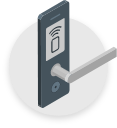 Bluetooth Door Locks
Bluetooth Door Locks Smartphone Controlled Sensors
Smartphone Controlled Sensors Cameras with Wi-Fi
Cameras with Wi-Fi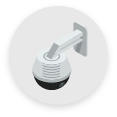 Security Cameras & Remote Monitoring
Security Cameras & Remote Monitoring Outdoor Cameras
Outdoor Cameras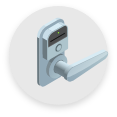 Fingerprint Scanners
Fingerprint Scanners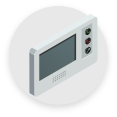 Intelligent Garage Systems
Intelligent Garage Systems Window Sensors
Window Sensors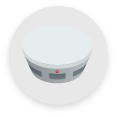 Glass Break Sensors
Glass Break Sensors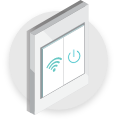 Light Automation
Light Automation Smart Doorbell
Smart Doorbell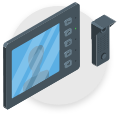 Digital Door Viewer
Digital Door Viewer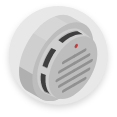 Smoke Alarms
Smoke Alarms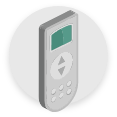 Motorized Blinds
Motorized Blinds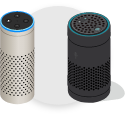 Automation Options For Home Security Devices
Automation Options For Home Security Devices Software for Securing Your Home’s Security Devices
Software for Securing Your Home’s Security Devices
